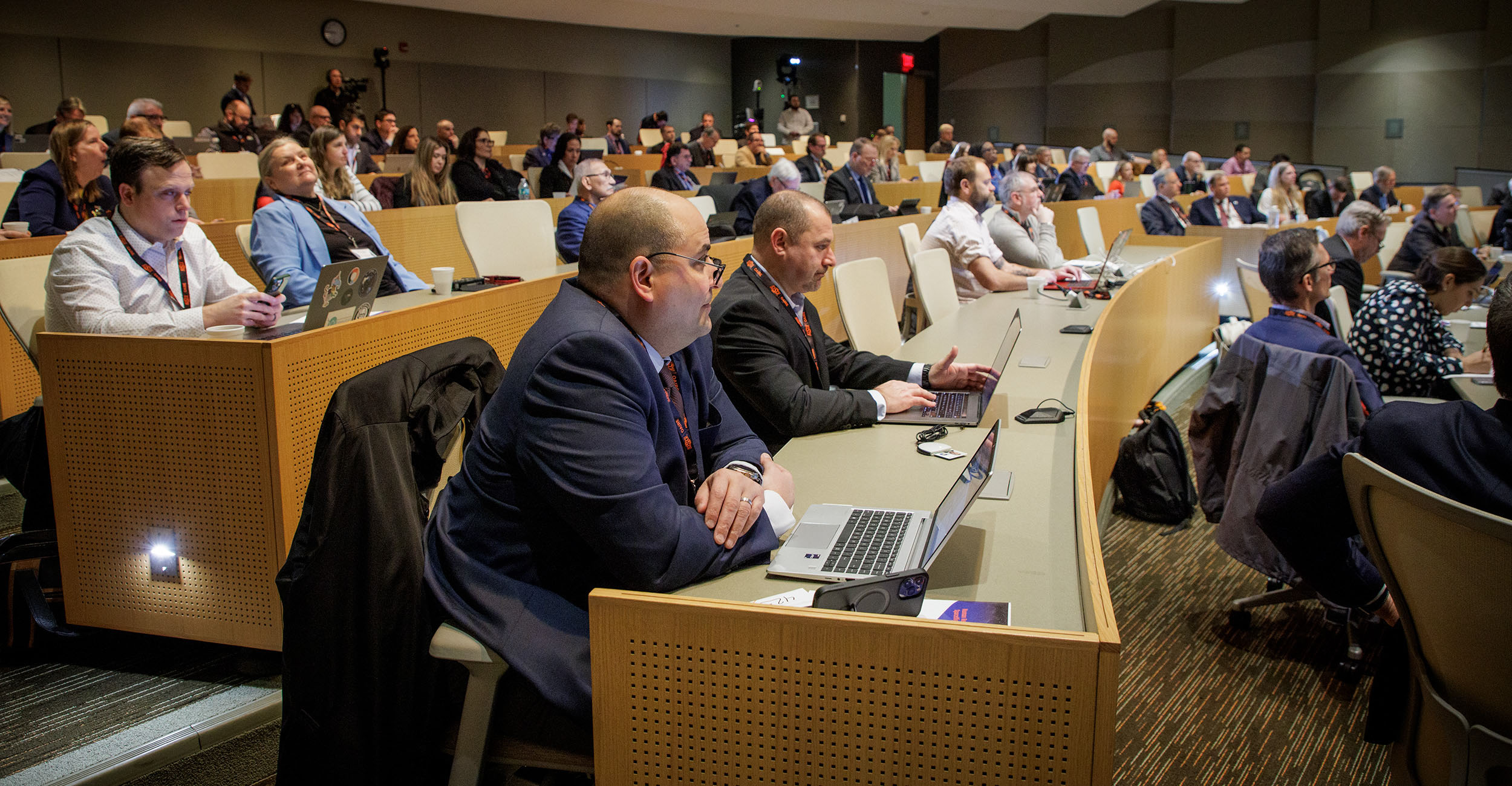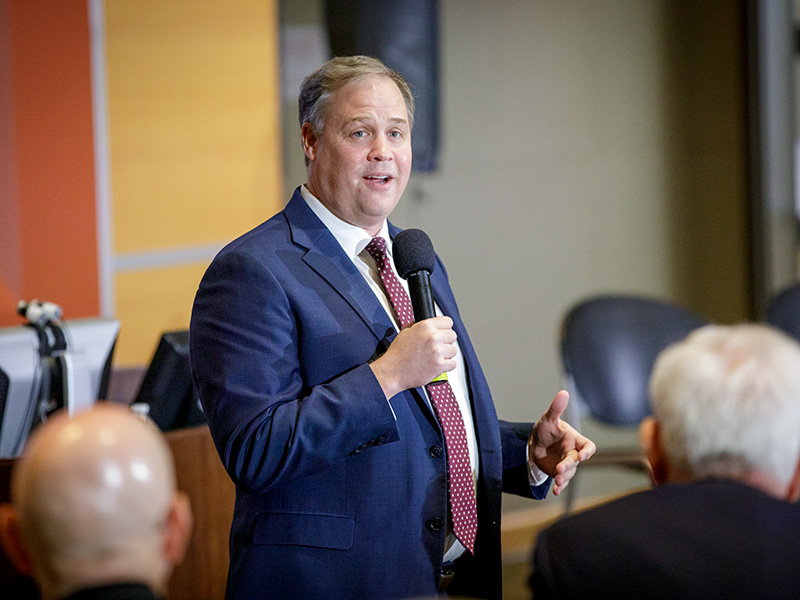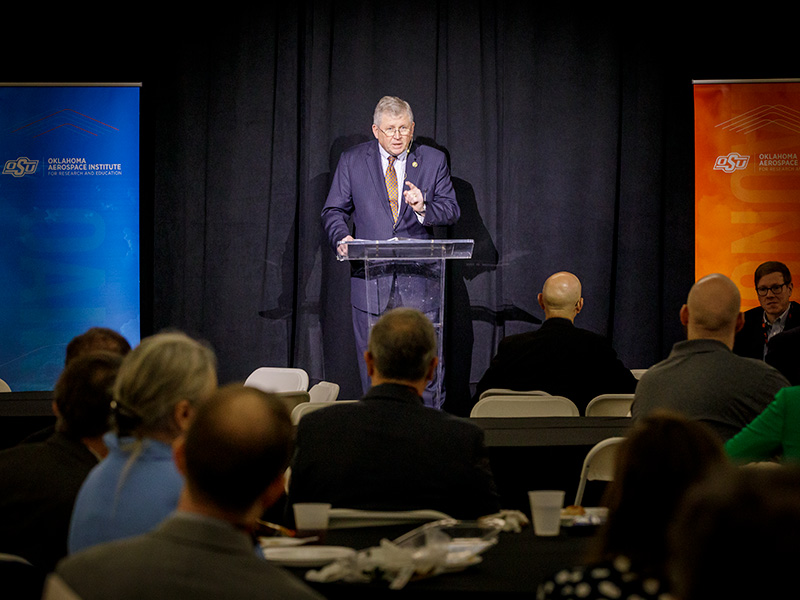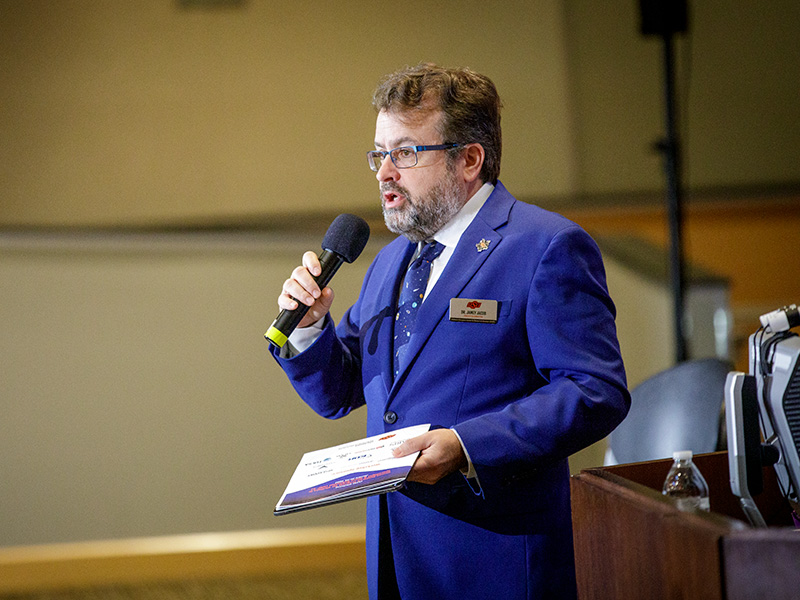
OSU hosts global aerospace leaders in conference concerning civilian space travel
Thursday, January 25, 2024
Media Contact: Shannon Rigsby | Associate Director of Public Information | 405-744-9081 | shannon.rigsby@okstate.edu
In the 1960s, the world watched as the exploration of the vast frontier of space suddenly seemed within reach.
And Tulsa played a significant role.
Jim Bridenstine, former NASA director, said Tulsa’s history with space exploration is rich — from supplying parts for the Saturn rockets to the mechanical arms on the Space Shuttle — and it began the day after President John F. Kennedy told the nation that the United State should “commit itself to achieving the goal, before this decade is out, of landing a man on the moon and returning him safely to Earth.”
“The day after, right here in the city of Tulsa, we had the first Peaceful Uses of Outer Space Conference,” Bridenstine said. “Wernher Von Braun, renowned leader of the National Aviation and Space Administration, and the Americans and German American engineers tasked with getting us to the moon descended on Tulsa. The Soviet scientists also came to Tulsa and together they talked about how space could be utilized in a peaceful way for humanity.”
Once again, leaders in space exploration from around the world descended on Tulsa in January with a common goal: to make space travel safe for everyone, including civilians.
The demand for commercial spaceflight is growing exponentially, and while technological developments have continued to advance on the shoulders of previous missions and discoveries, commercial spaceflight represents a new frontier where critical questions regarding human health and safety have yet to be answered.
Oklahoma State University welcomed global aerospace leaders Jan. 23 and 24, at the Human Research Program for Civilians in Spaceflight and Space Habitation (HRP-C) Conference to explore those questions and potential solutions.
The event was hosted by OSU’s Oklahoma Aerospace Institute for Research and Education (OAIRE) and the LaunchPad Center at the Helmerich Research Center on the OSU-Tulsa campus. The workshop — under the banner of the International Association for the Advancement of Space Safety (IAASS) — included leaders from NASA, the Federal Aviation Administration, commercial space companies, astronauts, and researchers from around the globe including Italy and Nigeria. The workshop provided a forum to discuss the health, safety and performance of civilians living and working in space in an exhaustive two-day conference.

Dr. Michael Marge — vice chair for the IAASS workshop planning committee and longtime scientific leader in health care advocacy at the National Institutes for Health, Health and Human Services, and NASA — said humanity is on the cusp of an exponential increase in space exploration as more private companies enter the commercial space race. That increase means more civilians will have access to frontiers that once belonged exclusively to astronauts in perfect health. Marge said more than 50% of the U.S. population has one or more chronic health conditions, from diabetes to kidney disease, and civilians will be bringing their health conditions and disease processes with them to space.
“The proposal that prompted the workshop was developed over months during think-tank sessions with spaceflight experts, scientists, spaceflight providers, medical experts and space agency representatives,” Marge said. “The conference presented a comprehensive program of research that we think will identify potential problems that humans face in space so that we can find countermeasures to reduce the risk and make it possible for them to go into space with good health, safety and comfort.”
Bridenstine said the hazards of long-duration spaceflight — from bone and muscle loss to blood clots and sometimes permanent changes in eyesight — have become evident as astronauts have spent more continuous time in space. And yet, researchers are uncovering new possibilities for revolutionary HIV and cancer treatments as well as growing human tissue in microgravity conditions.
“What we’re doing here is critically important for what we do as a nation and quite frankly as a globe as we move humanity off the Earth,” he said. “And it’s not just NASA astronauts — it’s not people in great physical shape. Everyone is flying into space. We have had 90 people fly in space who are not professional astronauts. For the commercial human spaceflight era we are entering, we have to take steps now to do it right.”
The idea of civilians traveling to and eventually living in space is relatively new, and the workshop is the first of its kind. Leaders provided information on risks to the human body in spaceflight, possible measurements for targeted research, the creation of data repositories so everyone can benefit and countermeasures to improve health and safety of civilians in space.
Dr. James D. Polk, chief health and medical officer for NASA, is triple board-certified as an osteopathic doctor, an emergency medical doctor and a flight surgeon specializing in aerospace medicine, and he recently earned his doctorate of education in applied education studies with an option in aviation and space education at OSU.
He stressed that it’s critical that an individual’s medical pathology is known and taken into account before they’re sent to space. Although NASA’s business is exploration and not the oversight of spaceflight outside the agency, NASA has made their astronaut selection standards available online as a resource for commercial spaceflight.
“The thing we worry about in commercial spaceflight isn’t that you’re going to fly more pathologies,” Polk said to the attendees. “The thing is to make sure you know the pathology you’re going to fly, how it’s going to interact and how it’s going to behave in microgravity.”
Thomas Marshburn, a former NASA astronaut and current chief medical officer at Sierra Space, spent 337 days in space and is the oldest person to perform a space walk at 61 years of age.

He outlined physical and mental changes that afflicted him in space that need to be considered when opening space to civilians. He was followed by medical experts like Dr. Jeffrey Jones of the Baylor College of Medicine; Dr. Bettina Beard of NASA; and Dr. Lori Ploutz-Snyder with the University of Michigan who tackled phenotyping as it relates to humans in space, physiologically, behaviorally and morphologically, respectively.
Dr. Michael Schmidt, Sovaris Space CEO and chief scientific officer, said the question is how to optimize gathering data to provide the greatest benefit. While the HRP-C has no regulatory role, the data gathered could be useful for companies working to commercialize space.
“It’s not the job of the HRP-C to decide who flies in space,” Schmidt said. “The HRP-C is really about how do we do the best possible kinds of research, generating extensive amounts of data and doing so in an unburdenedsome way. … This is really the foundation of how we’re building a program that’s going to be able to serve the entire industry if we all agree this is the way to go forward.”
Dr. Melchor Antuñano, director of the FAA’s Civil Aerospace Medical Institute, outlined many lingering issues for commercial spaceflight from age of consent and malpractice insurance for physicians who screen spaceflight participants to whether heart rate is a data point that needs to be collected since it naturally varies.

“The question is which variables are really important where we’ll have actionable information you can do something about,” he said. “We need to pay attention to not only what we measure and collect but how are we going to use that information and for what purpose.”
Congressman Frank Lucas, chairman of the House Committee for Science, Space and Technology, said his top priority as chair is to ensure American competitiveness and leadership in the fields of research and technology development, which includes space exploration and commercialization.
“I can assure you that the science committee will strongly support our human exploration efforts as part of the Artemis program,” Lucas said. Artemis is NASA’s return to the moon program.
“An important component of space exploration is continuing research on the International Space Station, which engages in human health research in lower Earth orbit. This research is vital. As we return our astronauts to the moon, and on to Mars, it will also benefit the commercial space sector as well.”
Dr. Jamey Jacob, executive director of OAIRE, said the workshop was a critical step in the effort to advance human spaceflight.
“This is the first of many meetings on commercial spaceflight OAIRE will be hosting through the auspices of the LaunchPad Center,” Jacob said. “Oklahoma has a long history in spaceflight, and we look forward to supporting future collaborations connecting industry and OSU’s innovation expertise as part of our journey to the stars.”
Story By: Shannon Rigsby | STATE Magazine
